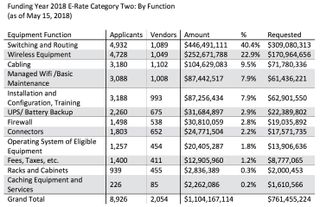FOLLOW THE MONEY: FUNDING INNOVATION

WHO IS IN THE MONEY?
Districts across the nation are in a constant contest to keep their tech relevant by raising bond funding. Here are some of the most recent winners:
School District 51 (CO) students scored 9,000 new Chromebooks for the next school year. The new computers are one of the most noticeable changes among several technology updates taking place while school’s out for the summer. The Chromebooks and charging carts were purchased with $3.18 million from a bond measure approved last November and will bring the district closer to its goal of having a computer or device for every student. The influx of technology brings the district’s technology ratio to one device for every two students, which is lower than the previous ratio of roughly one device for every three students. —The Daily Sentinel
Forsyth County (GA) voters have approved a $295 million school bond that supporters say will fund four new schools, new school technology, improved facilities, and safety measures in the coming years. More than $28 million of the total improvement costs will likely be covered by state funding. The proposed bond projects include $500,000 in improvements to elementary STEM facilities and $17 million for improvements to school technology. — Forsyth News
Guilderland (NY) Central School District will receive $531,447 from the state’s Smart Schools Bond Act, of which the lion’s share—$498,723—will go for classroom technology, including buying new Chromebooks for each middle- and high-school student. Another $32,724 will be used for school connectivity. A four-year replacement cycle will be set up for Guilderland’s Chromebooks. At the high school, for example, the newest ones will be given to ninth-graders; sophomores will get one-year-old devices; juniors, two-year-old Chromebooks; and seniors, three-year-old Chromebooks. —The Altamont Enterprise
WHAT ARE THEY BUYING?
According to the most recent figures from Funds for Learning, E-Rate applicants nationwide requested almost $748 million in discounts against the purchase of just over $1 billion in Category Two products and services, which are detailed in this chart (right). Designed to support the installation and upgrade of data networks inside school and library buildings, more than 75 percent of applicant sites nationwide have requested Category Two support since Funding Year 2015.
Tech & Learning Newsletter
Tools and ideas to transform education. Sign up below.
In looking at the FY2018 demand, it’s clear that the basic building blocks of network infrastructure represent the lion’s share of the services requested. Network switches and routers, as well as classroom wifi equipment, represent approximately 63 percent of total Category Two demand:
HOW TO GET IT
As states and districts update technology resources, it may seem that the needs overwhelm resources. Before major technology purchases, leaders will want to consider an approach and define goals that make sense for their particular region. The Office of Educational Technology in the Department of Education suggests asking these fundamental questions in your search for funds:
● What resources are presently available in schools, and how are they distributed? (For example, are there two computers in every classroom or a dedicated physical computer lab? Or are there mobile laptop/tablet stations?)
● What are the one-, two-, and five-year goals for terms of digital learning?
● What devices do students already bring to school? How do they use those devices?
● How fast are the internal and external connections in schools? How fast must they be to meet students’ and educators’ needs?
● What are the major strengths and challenges this area has in terms of technology?

INNOVATIVE PLANNING
To provide the best access to students and educators, leading states and districts think comprehensively about all funding and support. Individual situations vary, so the right mix of the approaches below will differ from place to place.
Leveraging economies of scale: At both the multi-district and multistate levels, school systems can negotiate more favorable rates with vendors by collaborating with others seeking similar devices and services. Louisiana, Maine, Illinois, and North Carolina, among other states, have done this successfully.
Public-private partnerships: Cross-sector collaboration can prove mutually beneficial. What major businesses and industries are in the region? Because they have a stake in ensuring that students graduate digitally literate, they may be willing to partner in funding, device donation, connectivity sharing, or training.
Cross-agency coordination: Some states and districts leverage higher education or medical facility resources to boost education access.
Device refurbishment: Repairing, upgrading, and reusing devices that businesses or community members no longer need can create both an educational opportunity and a source of low-cost devices. In making its transition to online assessment, Delaware used this strategy.
BYOD and student wireless access: Some states and districts leverage the devices that students already own, carefully considering privacy, security, and logistical issues. In other locales, it may be possible to negotiate very low rates for student wireless devices and services, which they could use both in and out of school.
Strategic decommissioning: What activities or resources are no longer needed? Areas to consider include paper textbooks, copy machines and supplies, fax machines and supplies, copper-line phone service, paper supplies, consumable workbooks, in-person trainings where virtual or peer-to-peer options exist, and printing (schedules, grades, announcements, etc.), among others, depending on the context.
Leveraging student experience: Where can students themselves serve as technologists, professional developers, and technicians? How can students support educators in advancing their technology-based professional capacity?











